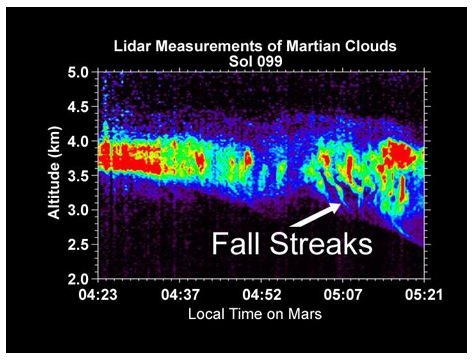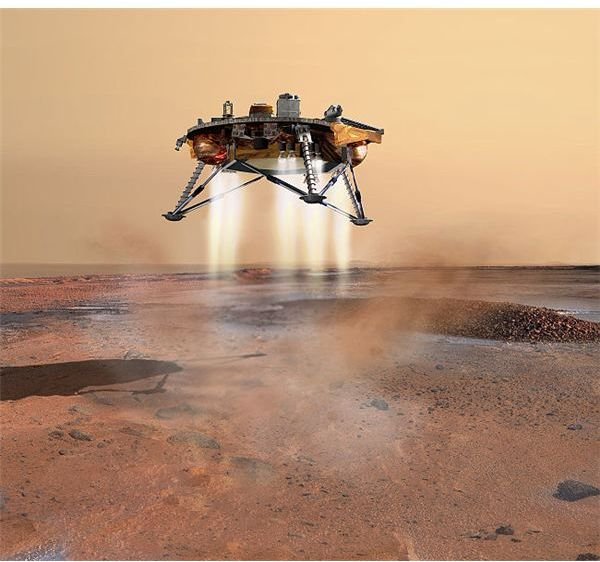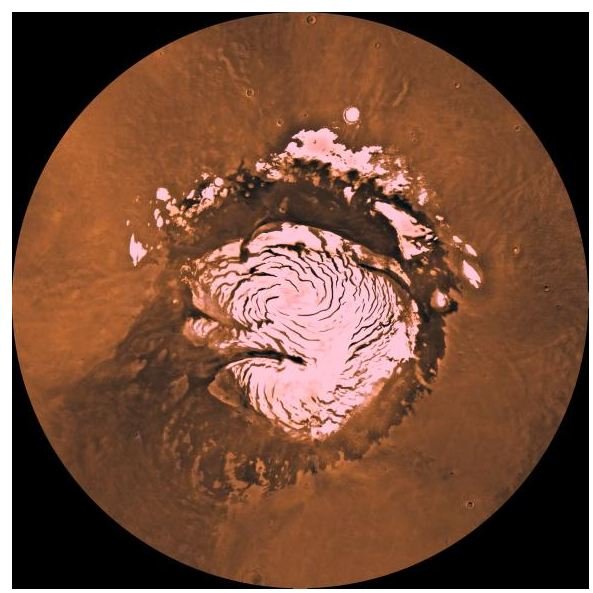Ice Caps in Mars - Dry Ice and Water Ice in the Polar Regions, Cirrus Clouds in the Martian Atmosphere and the Success of the Phoenix Lander
What Are The Ice Caps Made Of?
The ice caps of Mars are composed primarily of water ice and dry ice, or ice made of carbon dioxide. They exist in a seasonal and residual form, with the former melting during the summer months and the latter remaining year round. During the seasonal period, the southern cap reaches a diameter of 2485 miles (4000 km), while the northern measures 1864 miles (3000 km) in their respective winters. The dry ice portion of the caps reach approximately 3.2 feet (1 m) thick. During the summer months, the temperatures on Mars reaches above 81-degrees Fahrenheit (27 C) according to the Viking Orbiter Infrared Thermal Mapper, causing the ice to pass from solid to gaseous state through the process of sublimation. This releases the carbon dioxide, which is responsible for the major shifts in atmospheric pressure on the planet.
Above right: Mars Northern Polar Region. (Supplied by NASA; Public Domain; https://upload.wikimedia.org/wikipedia/commons/6/62/Mars_NPArea-PIA00161_modest.jpg)
Actions of the Mars Polar Ice Caps

The two permanent polar ice caps exist entirely in darkness during their respective winter season. Approximately 30 percent of the entire Martian atmosphere condenses into the ice caps of Mars. When the sublimation process occurs, large cirrus clouds develop. In 2004, the Mars rover Opportunity photographed one such occurrence.
The residual caps of each hemisphere are slightly different. During the summer months, the northern cap measures about 621 miles (1000 km) across and is composed primarily of water ice. This is expected to account for the majority of water on the surface. However, the southern cap is considerably smaller, measuring only 217 miles (350 km) in diameter and suspected of being mostly carbon dioxide ice.
Above left: Snow Fall on Mars. (Supplied by NASA/JPL-Caltech/University of Arizona/Canadian Space Agency; Public Domain; https://blogs.nationalgeographic.com/blogs/news/breakingorbit/breakingorbitimages/080929-mars-snow_big.jpg)
Are the Ice Caps Melting?
According to data from the Mars Global Surveyor and the Odyssey missions launched by NASA, the southern ice cap of Mars suffered from diminishing recurrences each year. First identified in 2005, the data leaves a controversial element to global warming throughout the solar system. According to the head of space research at St. Petersburg’s Pulkovo Astronomical Observatory in Russia, Habibullo Abdussamatov, this evidence points to the fact that solar radiation, rather than human intervention, may be responsible for the global warming effects we are also experiencing on Earth.
Phoenix Lander

On May 25, 2008, NASA’s Phoenix lander arrived on the surface of the red planet, descending into the northern polar region. During its mission, it was able to identify calcium carbonate in the soil, pointing to the existence of a damp atmosphere around the site. Additionally, during its tenure on the planet’s surface, the Phoenix lander took a visual record of snowfall from cirrus clouds.
Although data regarding organic elements were not fully identified, the fact that water is present opens up a number of possibilities for future missions to the ice caps of Mars.
Above right: Phoenix lander. (Supplied by NASA; Public Domain; https://upload.wikimedia.org/wikipedia/commons/6/6a/Phoenix_landing.jpg)
Resources
“Water on Mars” University of Texas: https://www.edb.utexas.edu/missiontomars/pdf/water1.pdf
“Mars Melt Hints at Solar, Not Human Cause for Global Warming” National Geographic: https://news.nationalgeographic.com/news/2007/02/070228-mars-warming.html
“Phoenix Mars Mission” University of Arizona: https://phoenix.lpl.arizona.edu/index.php
